39 introduction to bonding worksheet answers
Answers to Chemistry End of Chapter Exercises. 1. At the equivalence point in the titration of a weak base with a strong acid, the resulting solution is slightly acidic due to the presence of the conjugate acid. Thus, pick an indicator that changes color in the acidic range and brackets the pH at the equivalence point. Methyl orange is a good ... Introduction to Ionic & Covalent Bonding: Description Use simulation to observe properties of ionic and molecular compounds in conjunction with MSDS sheets. This is meant to introduce ionic and covalent bonding as well as the properties associated with the resulting compounds. Duration 60 minutes: Answers Included Yes
Worksheet Introduction to Solutions ANSWER KEY Worksheet u2013 Introduction to Solutions Part I- The Basics: 1. Define the following terms: a. ... (In terms of bonding, what 2 types of substances [Filename: Answers_2011_Wksht_Intro_to_Solutions.pdf] - Read File Online - Report Abuse
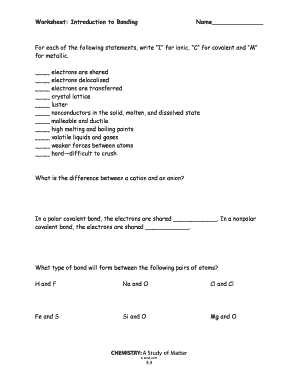
Introduction to bonding worksheet answers
Introduction To Chemical Bonding Worksheet Answers. There are four major types of bonds. By Celestine Aubry on November 2 2020. NFHS Honors Chemistry Chemical Bonding Unit. Explain why most atoms form chemical bonds. Atoms form bonds in order for each atom to have a complete outer shell and to become stable and happy. Read Free Chemistry Chapter 8 Covalent Bonding Worksheet Answers MCQ Questions for Class 11 Chemistry Chapter 4 Chemical Pure vs. Polar Covalent Bonds. If the atoms that form a covalent bond are identical, as in H 2, Cl 2, and other diatomic ... Chapter 5 - Covalent Bonds and Introduction to Organic Molecules Chemical bonds are generally ... Balancing Chemical Equations Worksheet Answer Key. Introduction to Bonding Make sure your answers are in your own words. Eight electrons in their valence shell. A nuclei c isotopes b inner electrons d lewis structures 2. Handphone Tablet Desktop Original Size If you want to know the types of bonds that make up the hydrogen and oxygen molecules ...
Introduction to bonding worksheet answers. 27.08.2021 · Matter exists in four states: solid, liquid, gas, and plasma. There are six changes of phase that occur among these states. Learn more about … STORY - Choose one type of bonding and write "A Day in the Life of an Atom" story describing what it's like to be an atom that forms your chosen bond type. The story should incorporate at least 5 properties from your Bonding Comparison Chart . Chemical Bonding Instructions: Use your web-searching skills to answer the following questions and to complete the "Bonding Comparison Chart". You may need to visit a wide array of sites in order to locate and validate your answers! Introduction to Bonding Make sure your answers are in your own words! 1. What is a chemical Bond? Bonding Worksheet #1: Introduction to Ionic Bonds. The forces that hold matter together are called chemical bonds. There are four major types of bonds. We need to learn in detail about these bonds and how they influence the properties of matter. The four major types of bonds are: I. Ionic Bonds III. Metallic Bonds. II. Covalent Bonds IV.
About This Quiz & Worksheet. The quiz will present you with different compounds and then ask you to identify the correct Lewis dot diagram. It will also ask you to identify the various conventions ... View Kami Export - Michael Salhab - Bonding Worksheet.pdf from CHEMISTRY 101 at Los Osos High. Worksheet: Introduction to Bonding Name_ For each of the following statements, write "I" for ionic, Chemistry 501: Introduction to Bonding Instructions Before viewing an episode, download and print the note-taking guides, worksheets, and lab data sheets for that episode, keeping the printed sheets in order by page number. Introduction. 2.1 Early Ideas in Atomic Theory. 2.2 Evolution of Atomic Theory. 2.3 Atomic Structure and Symbolism . 2.4 Chemical Formulas. 2.5 The Periodic Table. 2.6 Molecular and Ionic Compounds. 2.7 Chemical Nomenclature. Chapter 3. Composition of Substances and Solutions. Introduction. 3.1 Formula Mass and the Mole Concept. 3.2 Determining Empirical …
The chemical basis of all living organisms is linked to the way that carbon bonds with other atoms. This introduction to organic chemistry explains the many ways that carbon and hydrogen form bonds. Basic hydrocarbon nomenclature is described, including alkanes, alkenes, alkynes, and isomers. Bonding & IMF Worksheets and Answer Keys. Polar vs. Nonpolar Molecules & Their Properties. Polar vs. Nonpolar Molecules--Video by Crash Course Chemistry. Test Review. Test Review Answer Sheet. Bonds forces MC practice test-Answers on the last... 2015Hydrocarbons, IMFs Evaporation Lab Results. Topic 21. Topic 22. Fresh Juice Research. Topic 24 ... Read Online Worksheet Introduction To Bonding Answers Worksheet Introduction To Bonding Answers This is likewise one of the factors by obtaining the soft documents of this worksheet introduction to bonding answers by online. You might not require more grow old to spend to go to the book inauguration as capably as search for them. Introduction to Ionic & Covalent Bonding. Pre-Lab Questions. Define ionic bond: Chemical bond where electron(s) are transferred from a cation (usually a metal) to an anion (a nonmetal or polyatomic). The resulting opposite charges attract and the bond gives the atoms involved a full octet.
This worksheet and quiz will let you practice the following skills: Reading comprehension - ensure that you draw the most important information from the related how to calculate formal charge lesson
Bonding Basics Presentation (ppt) - I use this presentation on my SmartBoard as we complete the Bonding Basics lesson. Bonding Basics Review Worksheet (pdf) - A student worksheet reviewing oxidation numbers as well as ionic and covalent bonding. 2010 Version - Don't have time or materials to make the headbands? Try this one! For this version, I ...
Key For Pearson Ionic Bonds Review And Reinforce, PDF Gratis Answer Key For Pearson .... Aug 5, 2020 — Displaying all worksheets related to ionic bonding answer key. ... ionic bonds worksheet answers pearson ionic bonding practice worksheet .... Answer Key Pearson Education Chapter 7 Ionic And Metallic .
Practice: Introduction to biological macromolecules. Next lesson. Properties, structure, and function of biological macromolecules. Science · AP®︎/College Biology · Chemistry of life · Introduction to biological macromolecules. Chemical bonds. AP.BIO: SYI‑1 (EU), SYI‑1.B (LO), SYI‑1.B.1 (EK) Chemical bonds hold molecules together and create temporary connections …
Apr 09, 2021 · Covalent bonds this worksheet and answer key is a great way to assess students prior knowledge of ionic and covalent bonding. Explore learning gizmo answer key ionic bonds. Pin By Edwin On All Academic Assignments Found Here Ionic Bonds Good Grades Ionic Bonding Chemical family electron affinity ion ionic bond metal nonmetal ...
Displaying top 8 worksheets found for - Introduction To Bonding. Some of the worksheets for this concept are Wordpress at lps sites for lps staff schools, Chapter 4 ionic bond, Introduction to chemical bonding, University of texas at austin, Atomic structure and chemical bonds, Covalent, Chapter 8 covalent bonding work answer key, Icebreakers team building activities and energizers.
In a polar covalent bond, the electrons are shared _____. In a nonpolar covalent bond, the electrons are shared _____. What type of bond will form between the following pairs of atoms? H and F Na and O Cl and Cl Fe and S Si and O Mg and O
Worksheet #3 Continued. 1. Draw the bonds below: a) phosphorus . triodide (PI3) b) bromine (Br2) c) water (H2O) d) ammonia (NH3) 2. EXTRA CHALLENGE: Determine if it is an ionic bond or a covalent bond. Show the work and the final answer. Remember: Covalent bonds form between two nonmetals that share electrons.
View Homework Help - introToBondingWkst from CHM 111 at Roberts Wesleyan College. Worksheet: Introduction to Bonding Name_ For each of the following statements, write I for ionic, C for covalent and
worksheet introduction to bonding answers is available in our digital library an online access to it is set as public so you can get it instantly. Our digital library saves in multiple locations, allowing you to get the most less latency time to download any of our books like this one.
Online Library Worksheet Introduction To Bonding Answers Chemical Bonding - Kyrene School District This lesson is aligned with NGSS HS-PS1-1, "use the periodic table as a model to predict the relative properties of elements based on the patterns of
Chemistry - Bonding Packet Name:_____ Hr:_____ Page 5 5 Updated 3/31/2017 Worksheet #4: Introduction to Covalent Bonds A covalent bond is formed between nonmetal atoms. The nonmetals are connected by a shared pair of valence electrons.
Introduction to Ionic Bonds The forces that hold matter together are called chemical bonds. There are four major types of bonds. We need to learn in detail about these bonds and how they influence the properties of matter. The four major types of bonds are: I. Ionic Bonds III. Metallic Bonds II. Covalent Bonds IV.
Introduction When atoms bond together to form ionic compounds, they will not combine with just any other atom. For example, two atoms that will never form an ionic bond are a sodium atom (Na) and a potassium atom (K). This is because both Na 1+ and K 1+ are cations, or positively-charged ions.
Introduction to chemical bonding worksheet answers. Unit 6 chemical bonding notes worksheets honors 1 introduction to chemical bonding i. Cs is a metal so it is likely to form ionic compounds with a nonmetal. Mutual electrical attraction between the nuclei and valence e of different atoms that binds the atoms together b. What is a chemical bond.
Answers to Chemistry End of Chapter Exercises. 1. The reactants either may be moving too slowly to have enough kinetic energy to exceed the activation energy for the reaction, or the orientation of the molecules when they collide may prevent the reaction from occurring. 3.
Worksheet #1: Introduction to Ionic Bonds. The forces that hold matter together are called chemical bonds. There are four major types of bonds. We need to learn in detail about these bonds and how they influence the properties of matter. The four major types of bonds are: I. Ionic Bonds III. Metallic Bonds. II. Covalent Bonds IV.
Worksheet Introduction To Chemical Bonding Worksheet Answers by Amanda updated on July 2, 2021 Introduction to Chemical Bonding The focus is on the concept of generating new substances with new physical and chemical properties on a microscopic level. Lewis diagrams are clearly defined in. Chemical Bonding Worksheet Answers Key Promotiontablecovers
7.1 Ionic Bonding. 7.2 Covalent Bonding. 7.3 Lewis Symbols and Structures . 7.4 Formal Charges and Resonance. 7.5 Strengths of Ionic and Covalent Bonds. 7.6 Molecular Structure and Polarity. Chapter 8. Advanced Theories of Covalent Bonding. Introduction. 8.1 Valence Bond Theory. 8.2 Hybrid Atomic Orbitals. 8.3 Multiple Bonds. 8.4 Molecular Orbital Theory. Chapter …
25.08.2021 · Atoms have a variety of bonds that affect whether and how they share electrons. Learn about polar and nonpolar covalent bonds through examples, and explore peptide bonds, electronegativity, and ...
Which of the following molecules has the shortest bond length? a) N2. b) O2 c) Cl2 d) Br2 e) l2 Which of the following has zero dipole moment (i.e. is non-polar molecule)? a) H2O b) NO21- c) CCl4 d) SO3 2- e) HF Ionic bonds are the electrostatic attraction between oppositely charged atom. What determines their ionic strength?
The Ionization of Hydrated Metal Ions. Unlike the group 1 and 2 metal ions of the preceding examples (Na +, Ca 2+, etc.), some metal ions function as acids in aqueous solutions.These ions are not just loosely solvated by water molecules when dissolved, instead they are covalently bonded to a fixed number of water molecules to yield a complex ion (see chapter on …
ΔT 1 = K f m . where K f is a constant that depends on the specific solvent and m is the molality of the molecules or ions solute. Table 1 gives data for several common solvents.
Bonding Worksheet No 2 (Bonding Worksheet No 2.pdf) Bonding Worksheet No 3 (Bonding Worksheet No.3.pdf) Lewis Electron Dots Notes (Lewis Electron Dots Notes.pdf) Solutions. Solutions Worksheet (Solutions Worksheet.pdf) Solutions Review (Solutions Review Sheet.pdf) Organic Chemistry. Alkanes, Alkenes, Alkynes Worksheet (Alkanes, Alkenes, Alkynes ...
Balancing Chemical Equations Worksheet Answer Key. Introduction to Bonding Make sure your answers are in your own words. Eight electrons in their valence shell. A nuclei c isotopes b inner electrons d lewis structures 2. Handphone Tablet Desktop Original Size If you want to know the types of bonds that make up the hydrogen and oxygen molecules ...
Read Free Chemistry Chapter 8 Covalent Bonding Worksheet Answers MCQ Questions for Class 11 Chemistry Chapter 4 Chemical Pure vs. Polar Covalent Bonds. If the atoms that form a covalent bond are identical, as in H 2, Cl 2, and other diatomic ... Chapter 5 - Covalent Bonds and Introduction to Organic Molecules Chemical bonds are generally ...
Introduction To Chemical Bonding Worksheet Answers. There are four major types of bonds. By Celestine Aubry on November 2 2020. NFHS Honors Chemistry Chemical Bonding Unit. Explain why most atoms form chemical bonds. Atoms form bonds in order for each atom to have a complete outer shell and to become stable and happy.






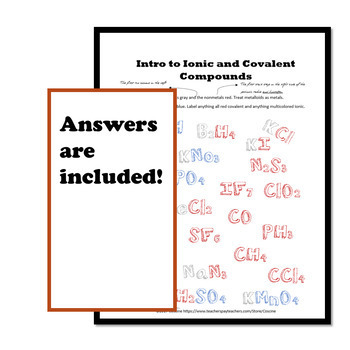







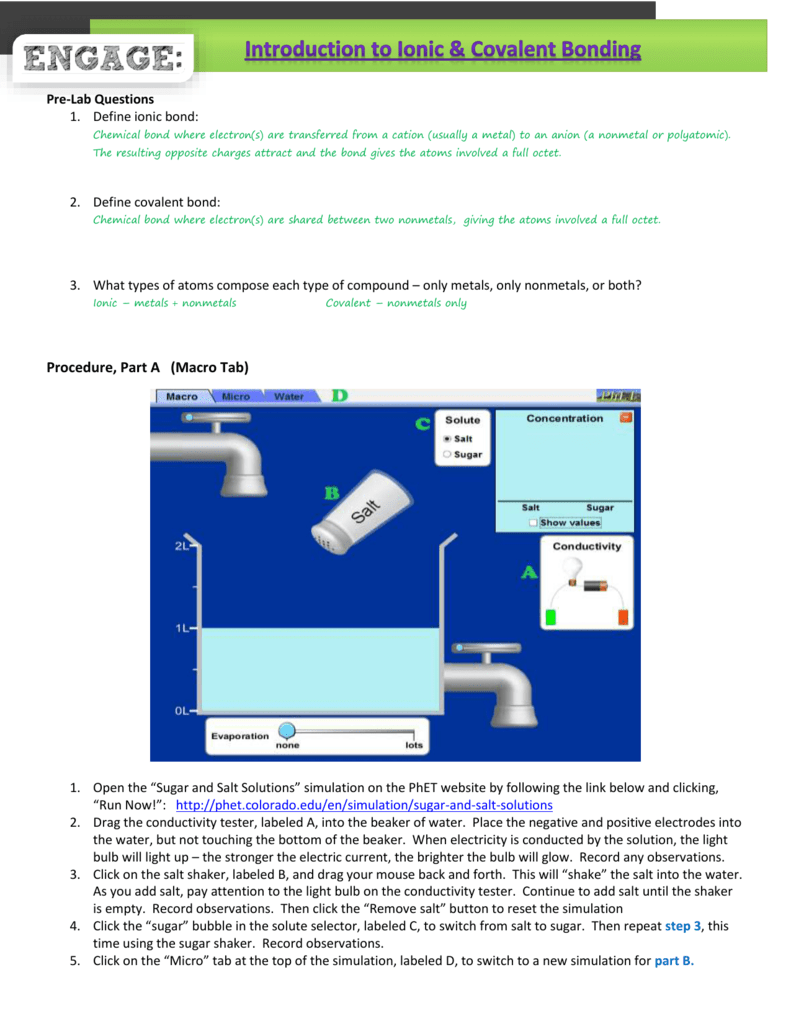
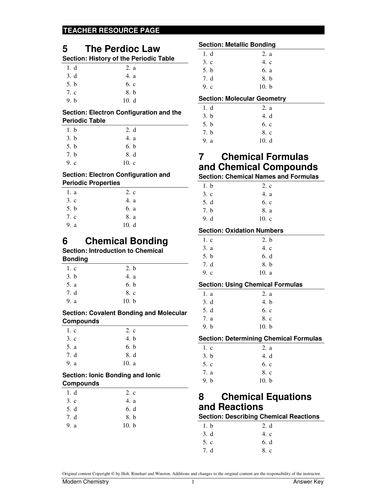




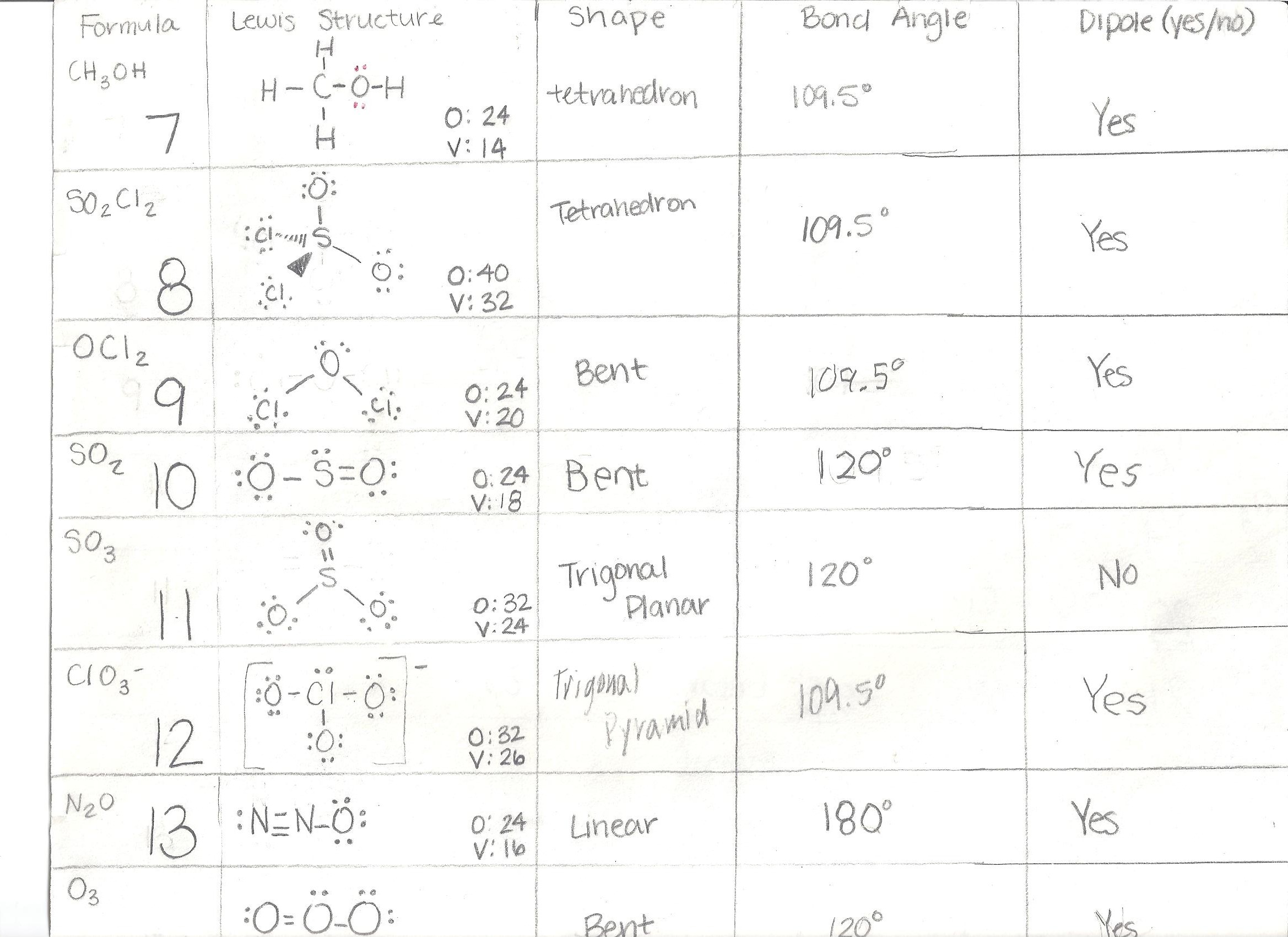







0 Response to "39 introduction to bonding worksheet answers"
Post a Comment